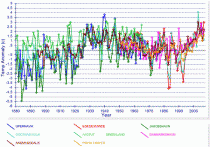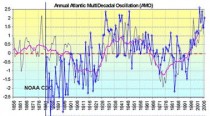(and they should know - surely - they run the weather station!)
By Verity Jones, Working in the Clay
“Unprecidented ice melt” being the big story in the Arctic, the temperatures here peaking in 2005 are certainly part of that story. But it is a story pushed by those with short memories or a blinkered field of view. In looking for modern photos of the weather station, I came across a gem - I stumbled on a sailing blog that included a voyage to Greenland. Sailing being a passion from childhood and the source of my weather obsession I couldn’’t resist reading er, rather a lot of it. Jim and Jean Foley arrived in Nuuk in the West of Greenland in July 2007. They had an obvious interest in how the climate is affecting Greenland, asking one guest, a student, about it, who said:
“...Disko Bay used to freeze over enabling dogsleds to cross the ice from his home on Disko Island to the mainland for most of the year. The last freeze was ten years ago. Now, helicopters are the only link when the brash ice gets too thick for boats.”
Down the steps Prins Christian Sund from the Weather Station. Image. In mid-August 2007 they were, briefly, guests of the weather station at Prins Christian Sund, and spent what sounds like a very pleasant evening having dinner with the station operators.
“We called ahead to the Danish weather station perched next to its antenna farm on the last wind blown mountain top at the eastern entrance of the sound. We had hoped to be able to tie their pier for our last night before leaving for Ireland. We were granted permission.
The station was originally built during WWII as a US weather base for 30 weather men and telegraph operators. Today, airplanes on the transatlantic run rely on its data. The march of technology has made it fully automatic and reduced the staff to three, a maintenance person, a cook and a manager.
Their number of annual visitors can be counted on one hand. We arrived to find Oleg, the manager and most of the staff waiting to help us tie up on their dock. We were invited to climb up to the station for a shower and dinner.
We gathered our clean clothes and climbed the stairs to find a compound of buildings tied down by a spider web of steel cables to keep them from blowing away.
After cocktails, dinner with wine and desert with schnapps we discussed global warming (they believe it is cyclical) and life in the universe (there must be).”
The weather station operators at this station believed global warming is part of a cycle.

Greenland - weather stations with a long record (enlarged here)
If this concept is new to you, there is plenty of evidence to support it from weather stations in the region (map left; scroll down for graphs), and it is throughly discussed on many sites and blogs. Alan Cheetham at Appinsys has a summary of recent and historical temperatures in Greenland and a couple of his figures are reproduced below. Tony Brown of Climate Reason has also researched the subject from a historical viewpoint and had a great post on Watts Up with That (Historic Variation in Arctic Ice) this time last year. Thanks to Tony I also became aware of a website and book How Spitsbergen Heats up the World, from which I reproduce the following figure: It is also possible to compare the rate of warming and see that the trends for many Arctic stations are comparable on interactive maps for the periods 1910-1939 and 1990-2010 but contrast with the cooling period 1940-1969 (see also Mapping Global Warming).

(enlarged here)
Going back to Alan Cheetham’s graphs, he has calculated the temperature anomalies for long-lived weather stations in Greenland. The graph below clearly shows the cyclical nature of the temperature anomaly, and also that the rates of warming are similar in the 1920s to currently. He has also superimposed the average temperature anomaly on the AMO.

Temperature anomaly history of GHCN stations in Greenland (reproduced from here, enlarged here).

Averaged temperature anomaly for longlived Greenland GHCN stations overlay on the Annual Atlantic Multidecadal Oscillation index (Figure from Appinsys, enlarged here).
Going further back in time, ice core data (oxygen and nitrogen and argon isotopic ratios), sediments and many other proxies are reviewed here. So no more talk of unprecedented ice melt or warm temperatures in the Arctic. People using such language are: pushing an agenda, have not looked at the length and breadth of the data, or have short or selective memories.
See full post here.




